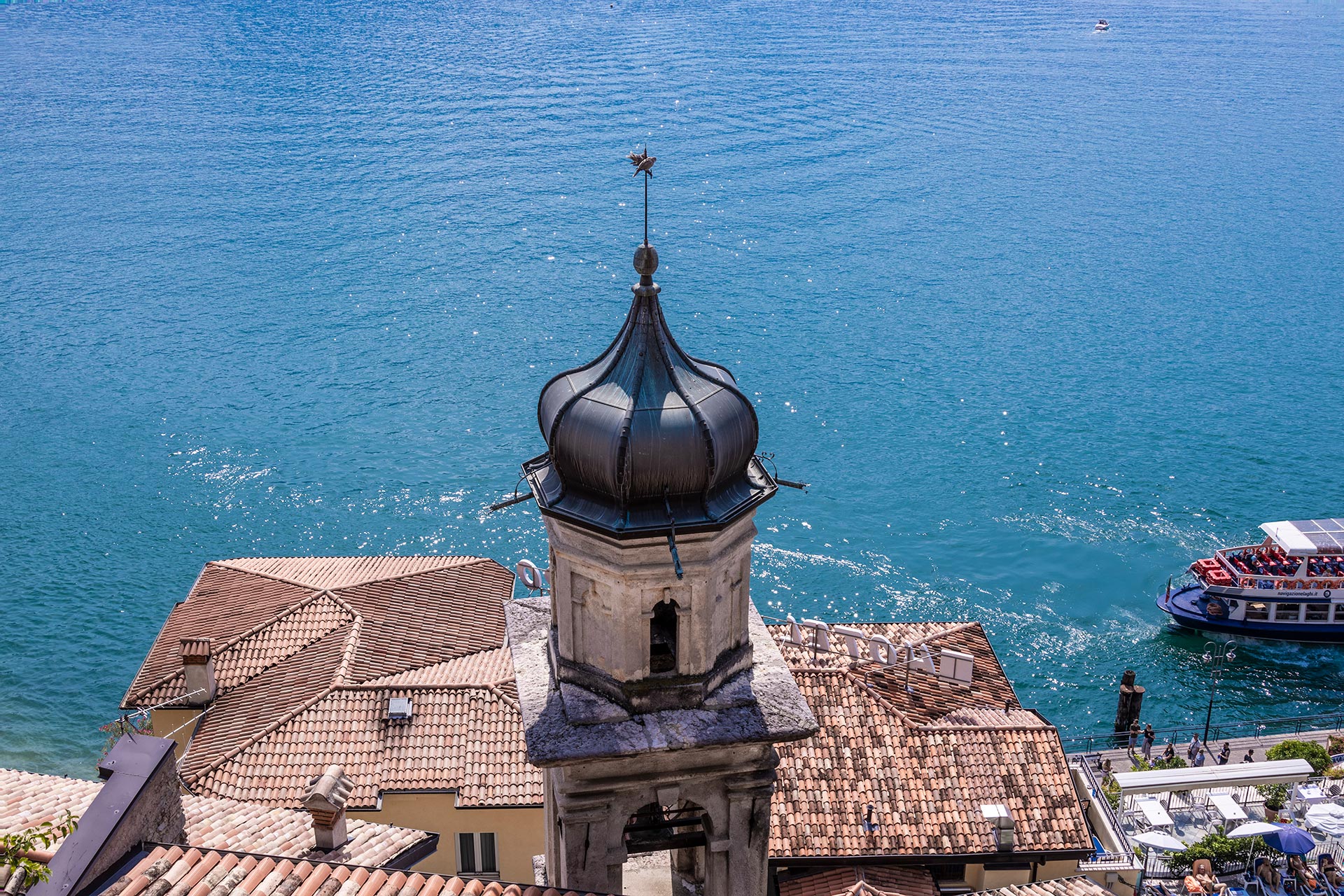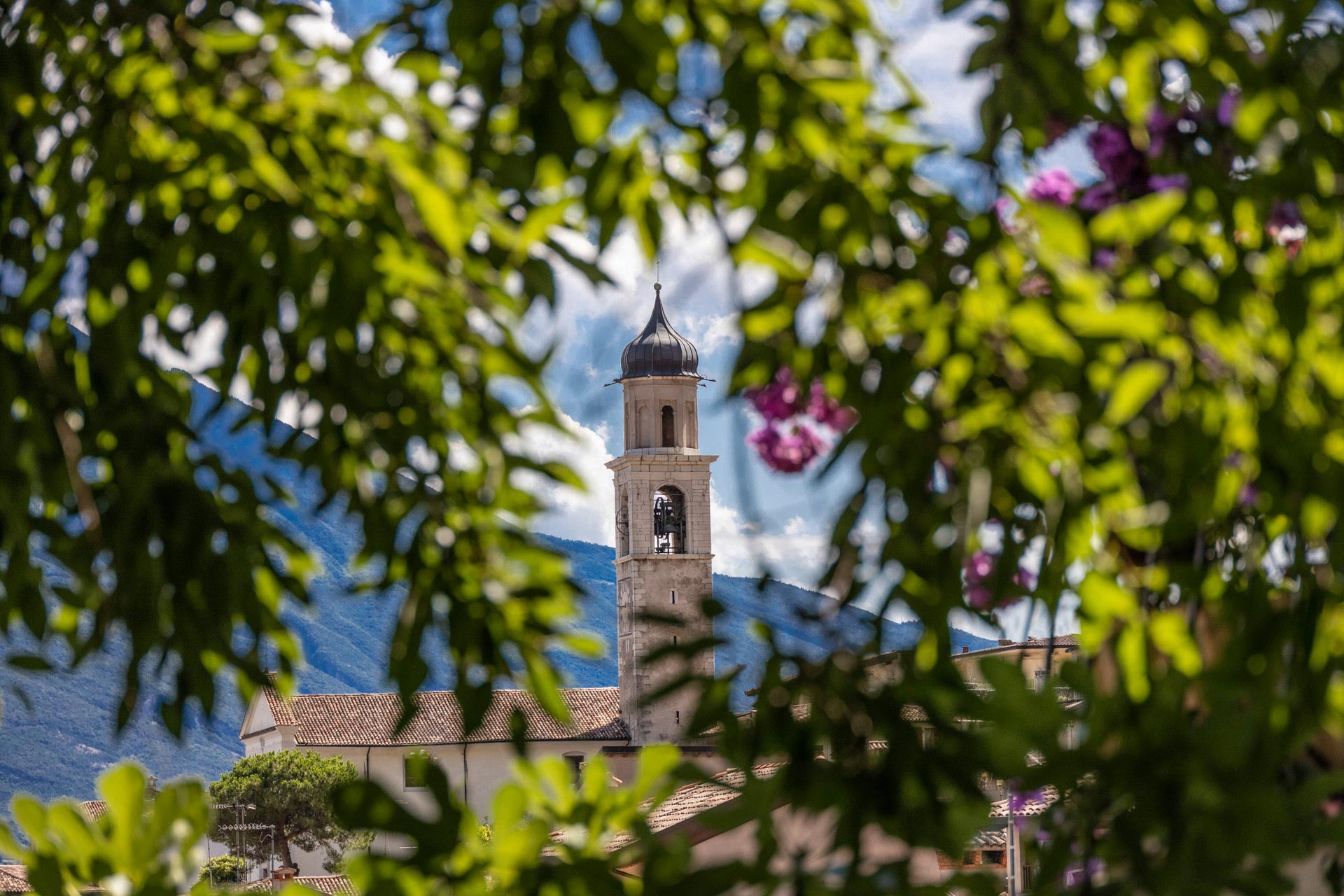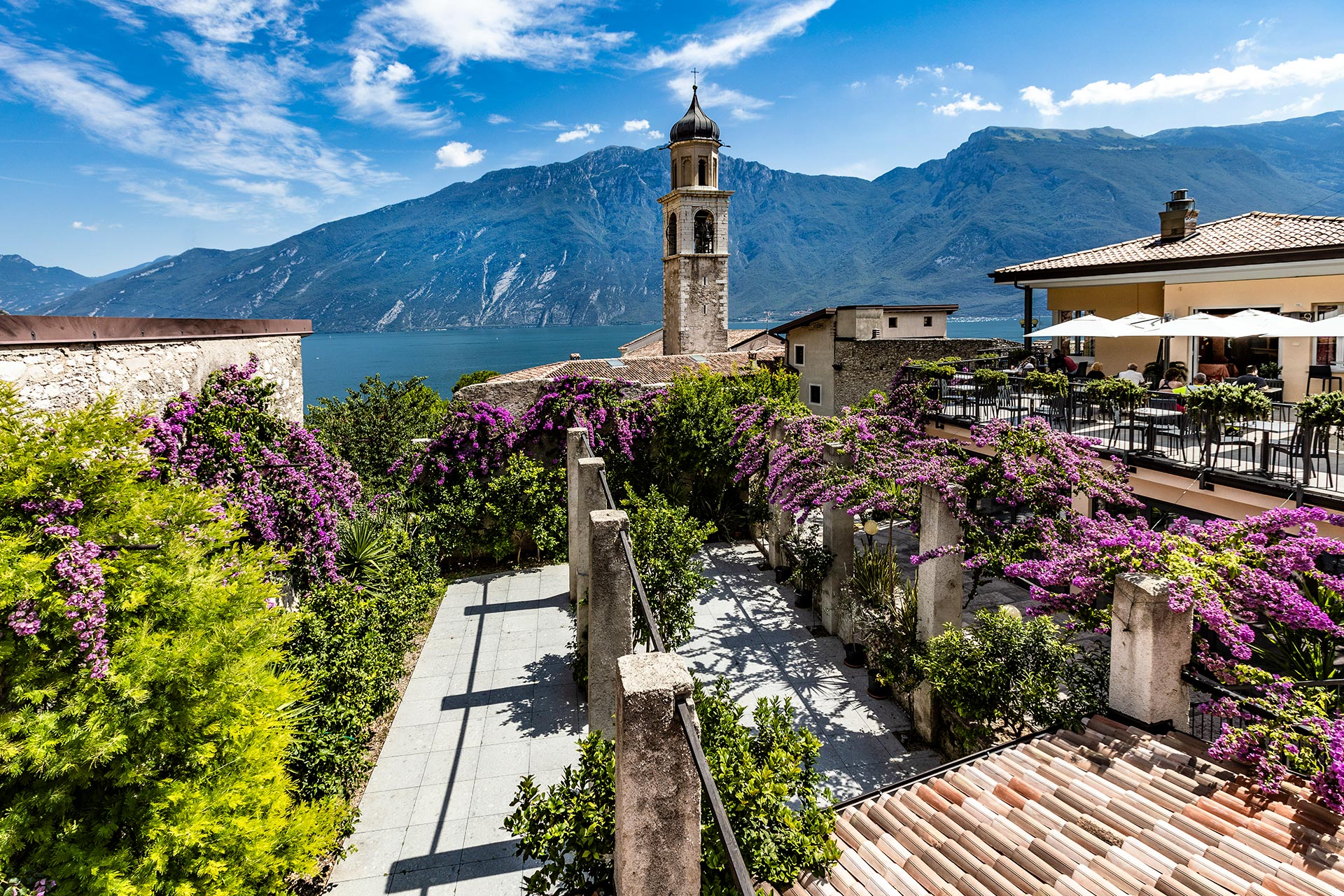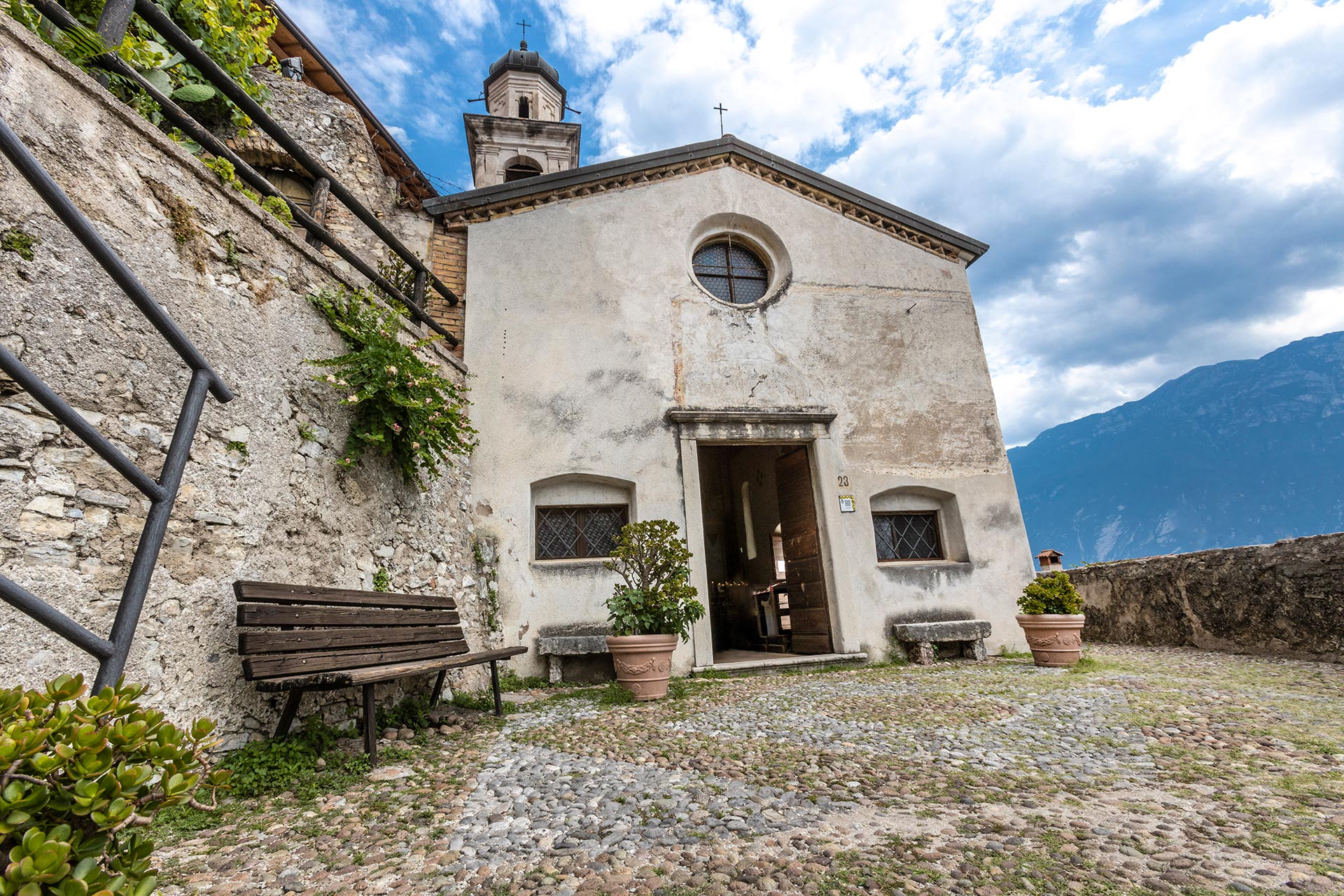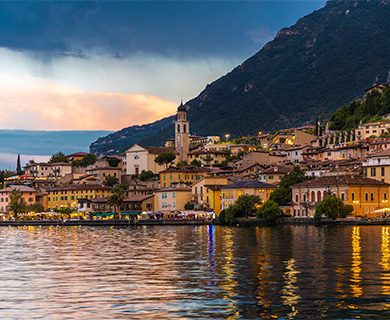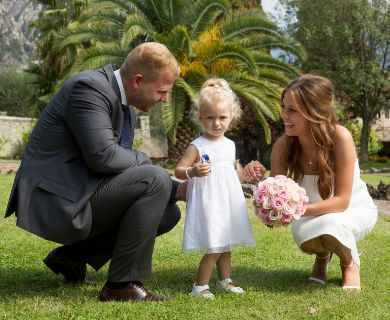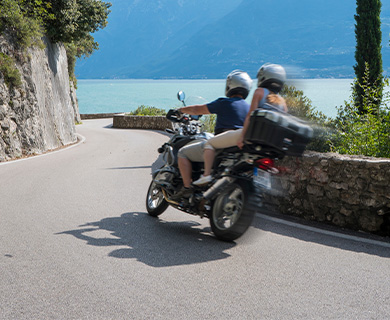The Churches, the Santelle and the Comboni Missionary Center in Limone sul Garda
Among the treasures of Limone sul Garda, an important place is occupied by the churches and the Comboni Missionary Center. The history of Limone is also told thanks to the cloisters and frescoes that have contributed to the beauty of this small town.
The Church of San Pietro
The church of San Pietro, also known as San Pietro in Oliveto (because of its position among the olive trees), dating back to the 9th century, is the oldest in Limone.
The church is Romanesque in style, with a single nave. Inside, there is a small white marble stoup and some beautiful frescoes, which came to light in 1989 and were restored in 2006. The simplicity of the church and the essentiality of the frescoes show how much the life of the community in the past was driven by feelings of deep religiousness. The population maintained (until after the war) the custom of going there for the rogation: penitential processions to implore the good outcome of the sowings and harvests and occasionally to ward off natural disasters, diseases, and epidemics. The frequency of processions was reduced over time, from once a month to the single date of St Peter's Day (29 June).
The exterior of the church is simple, with a small portico where you can still read phrases that testify to important events such as the plague of 1630, the defeat of Napoleon, the barren olive harvest, and the inclement seasons. Until the First World War, there was a bell tower, which was intentionally knocked down because it was a dangerous landmark for the nearby cannon emplacement at Crocette. The small church is therefore a precious document of religion, art and history.
The former small church of San Carlo
The former small church of San Carlo, whose construction is estimated to have taken place around 1905, stands in the old town center, near the church of San Benedetto. It was built by a citizen of Lemon in memory of her husband and dedicated to St Charles. During the Great War, it was also used as a supply depot for the troops; around 1930, the altar and sacred furnishings were removed. The building was later used for civilian events and during World War II it was requisitioned for military use. Since the 1960s, cultural and charitable activities have been held here.
Capital of the Madonnina
It stands in Milanesa Str, along the paved road (formerly the mountain road) leading to the place of the same name. The capital is in the shape of a flat arch with a roof. It is so called because of the image of the Madonna that is depicted on a column. The district "dela crose seu capitello" was already mentioned in the "estimo" of 1556, and the "contrada della madonnina ossia dei ronchi" in a deed of 8th November 1763.
The Santella, which was in very poor condition after the Second World War, was restored at the expense of the Angelo Codogni family, who wanted to fulfil a vow for the return of their grandchildren from the war. The fresco dates back to 1982 (previously there was a painting); in the same year the wall structure was restored, and two steps were removed to allow easier transit of vehicles.
Milanesa capital and the bridge of St John of Nepomuk
It is situated in the village of the same name, near the bridge over the St Giovanni stream. According to oral testimonies it dates to 1912-1913. There used to be a small painting of the Madonna and Child. It was renovated in 1982.
Parallel to the bridge of the Gardesana road over the S. Giovanni stream, there is a small ancient bridge that, until the Gardesana road was built, was the link from Limone to the olive grove. A wooden bridge had stood there since ancient times, but it was in 1647 that the first masonry work was carried out. Over the years it was damaged and destroyed by flooding from the river but was always rebuilt.
At the beginning of the bridge, there is a capital with a beautiful statue of St. John of Nepomuk, Priest and Martyr dated 1728: protector against floods and drowning. John of Nepomuk was one of the most celebrated saints during the 18th century. The sculptures, normally placed next to rivers or bodies of water, recalled the way in which the saint was martyred; John was in fact thrown into the waters of the Vltava in Prague on the orders of King Wenceslas IV in 1383. Chroniclers of the time say that the saint, confessor to Queen Joan of Bavaria, had angered the king by refusing to break the confessional seal.
The patron saint of the Austrian Imperial Army, thanks to the personal devotion of the Empress, during the rule of the House of Austria, to which the territory of Limone sul Garda belonged, the cult of the Saint spread throughout the Hapsburg territories as early as 1724 and the capital was probably also built-in deference to Empress Maria Theresa.
Canonized in 1729 under Pope Benedict XIII, the veneration of St John of Nepomuk is widespread in various European countries. For this reason, some propose him as one of the patron saints of the European continent.
The Church of San Benedetto
On 18th September 1532, with a document of the bishop of Brescia Francesco Cornelio, the Community of Limone was granted a resident priest and a baptismal font at what is now the Parish Church of San Benedetto.
As well as looking after the churches and the spiritual life of the faithful, the parish keeps the historical archives of the community, since until the second half of the 19th century, the task of registering baptisms, marriages and deaths was entrusted to the parish priests. The parish church was built in 1691 by Andrea Pernis, from Como, by enlarging an earlier small Romanesque church, which seems to date back to before the 11th century and is mentioned in a bull of Pope Urban III in 1186. Mass is still celebrated there today. In the winter of 2006-07, the bell tower was restored. It houses artistic masterpieces from the beginning of the 16th century. The great missionary and bishop St. Daniel Comboni was baptized in the church.
Numerous artistic masterpieces are kept in the church:
- The high altar (1724) is by Cristoforo Benedetti of Brentonico. The altarpiece (1547) depicts the deposition of Jesus; it is by Battista d'Angolo, known as il Moro, from Verona. On either side are two magnificent paintings by Andrea Celesti from the early 18th century.
- The altar of the Holy Sacrament (1699) is by Silvestro and the Ogna brothers of Rezzato. The altarpiece depicting the Last Supper is of unknown artist and age.
- The altar of the Holy Rosary (1704) is by Cristoforo Benedetti. The altarpiece represents the Madonna and Child, the mysteries of the Holy Rosary and St. Anthony and St. James of Compostela.
- The altar of St. Anthony of Padua (1696) is of inlaid marble and polished stucco. The painting (1847) is dedicated to St. Anthony, St. Francis and the Holy Family. The painter is Antonio Moro from Limone.
- The altar of the Crucifix (1721) is still the work of Cristoforo Benedetti; the beautiful baroque crucifix is made of boxwood.
- On the triumphal arch is a fine sculpture by Benedetti depicting the Annunciation.
- The organ above the main entrance was built by Damiano Damiani in 1831.
- The baptistery dates to the end of the 16th century: it was commissioned by St Charles Borromeo who visited the parish on 10th August 1580.
The Church of San Rocco
Situated north of the historical center, the church of San Rocco was built in the first half of the 16th century as a thanksgiving for the people of Limone who had escaped the contagious plague that hit most of northern Italy in those years. The church was finished over the next two centuries, with frescoes on the walls and a bell tower. During the First World War it suffered extensive damage, but fortunately, in 1957, restoration work brought to light some paintings dating back to the 16th century. The church is well integrated in the landscape between the rock, the lake, and the lemon groves, and is one of the most popular places in the town as it is reached by a characteristic staircase that is always adorned with flowers and typical Garda plants, making it one of the most picturesque and photographed views. Liturgical services are still held here today, as well as the feast of San Rocco (16 August).
Saint Daniel Comboni
15th March 1831 Daniele was born in Limone sul Garda, into a humble family that lived in the house of the Limonaia - keeper in Tesöl (curiosity: at the time, and until 1859, Limone was part of the Austro-Hungarian Empire and Daniele Comboni was therefore born with Austrian nationality).
February 20, 1843, (at the age of 12) he was accepted into the Mazzaniano boarding school founded by Canon Nicola Mazza in Verona for poor but gifted boys.
On 6th January 1849, (at the age of 18) he swore to consecrate himself to the evangelization of Africa, or rather, of "Nigrizia", as the continent was commonly called at the time.
Until 1854, (at the age of 23) at the Mazza boarding school, he studied with profit the main European languages of the time (French, German and English).
31st December 1854, (at the age of 23) he is ordained a priest in the Cathedral of Trent by the Bishop himself, Blessed De Tschiderer.
September 6, 1857 (at the age of 26) his first trip to Africa; he set sail from the port of Trieste with five other missionaries and a layman to realize his dream, participating in the Mazzanian missionary expedition to Central Africa, according to the "Plan" of Fr Nicola Mazza (his college master). Travelling at that time was not easy in Europe, let alone in Africa, where the lack of reliable maps and modern means of transport was compounded by the heat, diseases caused by insect bites or the normal consumption of food and water. For a European, it was certain death and leaving for the mission without knowing when or if they would return.
In spite of these adversities, the missionary group reached Kathoum in Sudan on 8th January and travelling up the White Nile they arrived at the mission guarded by the sole survivor of five German missionaries. (curiosity: Daniel was always in contact with German institutions and missionaries; he himself, in his European or African itineraries, travelled under the protection of the House of Habsburg or the Emperor of Austria, a consular visa which was very important and unlimited at the time).
In 1859, (at the age of 28) Daniele returned to Verona; he was the only survivor of the missionary group that had left Trieste three years earlier; he was already ill, but he wanted and obtained a commission to train African boys who had been rescued from slavery (at that time Africans were only considered for this type of market). It seems incredible, but in that first mission Daniel succeeded in forming dictionaries and grammars of the unwritten African languages he met; the Denka, the Bari, the Cordofan and the Nuba.
15th September 1864 (at the age of 33) is a defining moment in his life. While praying in Rome at the tomb of St Peter, he is inspired by the 'Plan for the regeneration of Africa through Africa itself'. Reflecting on his experience, he had concluded that the mission in the African reality required a change of method. If the deadly climate and environmental conditions did not allow European missionaries to penetrate directly, it was necessary to prepare the Africans themselves. This meant that the salvation of Africa had to be achieved through Africa itself. This was a strong consideration for the Church at the time, since the African was not considered to have the same dignity as other men, whereas Daniele's intuition recognized that Africa, "La Nigrizia", was capable of redeeming itself at all levels: moral, cultural and social.
August 1865 (at the age of 34) Fr Nicola Mazza, founder of the Mazzaniano Institute to which Daniele belonged, died. His successor, given the worsening financial situation of the Institute and other difficulties posed by those who no longer had faith in the mission, closes the African enterprise for good. Daniel was left alone.
In May 1867 (at the age of 36) Daniele opened in Verona, in a humble house, the Male Institute for the Missions of Nigrizia (later to become the Comboni Missionary Institute); it is a point of reference for those missionaries who want to continue their work. They came from those institutes that for financial reasons no longer supported the African missions. Towards the end of that year, he left for Egypt with three Camilian Fathers, three French nuns and 16 African girls educated in Europe, with the intention of founding one of the first planned Institutes in Cairo. He urgently returned to Europe to personally gather men and means; he therefore undertook several trips to one or other of the European capitals (France, Germany, Austria, England, Belgium, Switzerland, Russia, and Holland). It was important for his "Plan" that the missionary work should not be the prerogative of this or that country, but a unique and European work; Africa should not be westernized but valued or "regenerated" with its own culture and traditions.
In January 1872 (at the age of 41) he founded the Institute of the Pious Mothers of ‘Nigrizia’, the first female missionary institute in history, the first founded by Daniel. An institute which was greatly desired, and which would later be fundamental to the Comboni Work to this day. Daniele wrote about them in a letter: "... With the same ease with which they teach the ABC to the derelict orphan in Europe, in central Africa they face journeys of months and months under 60 degrees, they cross deserts on camels and mount and dominate horses, they sleep in a clear sky under a tree or in the corner of an Arab boat, they threaten the armed Bedouin, they rebuke man's vice, they assist the soldier in the hospital, they demand justice from the Turkish courts, and from the pashas, on behalf of the unfortunate and the oppressed, they do not fear the hyena or the roar of the lion... ". On 26 May Daniel was appointed Apostolic Provicar of Central Africa. The missionary spirit was so strong at that time that the first African collaborators were already being counted.
In May 1873 (at the age of 42) he entered Khartoum and dedicated himself to the implementation of his "Plan".
In 1876 (at the age of 45) Daniele returned to Europe, with the concern of setting up the two Missionary Institutes in Verona, personally seeking funds and men.
On 11 July 1877 (at the age of 46) he was appointed Apostolic Vicar of Central Africa and consecrated Bishop on 12 August, with the titular see of Claudiopolis (the Latin name for the city of Cluj in Romania). He returned to travel throughout Europe to promote the missions. On 3 December he left for Africa with the first five Pious Mothers of his Institute.
In April 1878 (at the age of 47) she was in Khartoum, received with a triumphant welcome; immediately she had to face an emergency of famine and hunger such as had never been seen in Sudan.
In 1879 (at the age of 48) he was forced to return to Italy, debilitated by continuous fevers. Demonstrating incredible tenacity for his mission, he took the opportunity to set up his Institutes in Verona for good.
In 1880 (at the age of 49) he returned to Sudan and began visiting the missions of the Vicariate (Khartoum, El-Obeid, Malbes, Dilling). He went on to explore the Nuba mountains with the idea of founding a mission further into Africa. Daniel had a strong physical constitution, but the enormous physical and moral fatigue (many missionaries, co-workers and nuns died suddenly of illness), and sacrifices of all kinds were fatally marking him.
On 5th October 1881 (at the age of 50) he was seriously stricken by fevers. On 10th October he died, assisted by his sisters and a Canadian missionary who was present. The following day his body was buried in the garden of the mission.
During the Mahdist revolution (1881-1898), many missionaries were killed for religious reasons and many missions were destroyed. Daniele Comboni's tomb was desecrated, and his bones dispersed. When the first two missionaries were able to return to Khartoum, they found a few fragments of bones, which were collected in an urn later placed in the church in Aswan (Egypt).
Shortly after 1900, Daniel's far-sightedness in his intuition "Save Africa with Africa" bore new fruit and two Comboni Institutes with a lay orientation were founded: the Secular Institute of Comboni Missionaries in 1969 and the Comboni Lay Missionaries in 1990.
On 6th April 1995 the miracle worked through his intercession in favor of the Afro-Brazilian girl Maria José de Oliveira Paixão was recognized.
17 March 1996 Daniel Comboni was beatified by Pope John Paul II.
On 20 December 2002 the second miracle worked through his intercession on behalf of the Sudanese Muslim mother Lubna Abdel Aziz was recognized.
5 October 2003 Daniel Comboni is canonized by Pope John Paul II.
Le Santelle (The Capitals)
As a testimony of the deep religiousness of the past, besides churches and chapels, in Limone there are still many frescos, crosses and aedicules with a sacred subject, commonly called "capitèi". Symbols of faith, hope or gratitude, they are placed on the façades of houses, at crossroads, along the roads that joined the village to the countryside (Capitelli Street is characteristic in this sense) and the paths that climbed up towards the mountain. The population is particularly devoted to the "capitèi" of the "Madonna del bis", in Capitelli Str., of the Madonnina, in Milanesa Str, of San Luigi, Fasse, of San Giovanni Nepomuceno, in Tamas Str., at one end of the little bridge over the stream.
